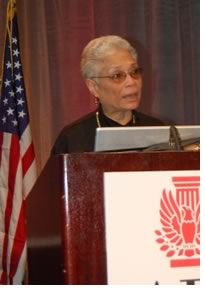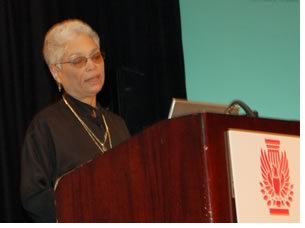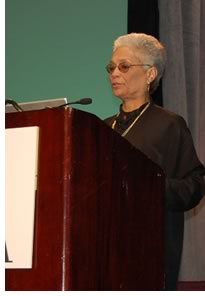

2/2006
Grassroots keynote speaker asks AIA leaders to “relentlessly question” diversity practices

by Tracy Ostroff
Diversity in architecture can be achieved, Sharon Sutton, PhD, FAIA, told 2006 Grassroots Leadership and Legislative Conference attendees in her February 9 keynote address. But despite many steps forward, she said it is clear that the profession and the society that it serves have not realized that potential. “Only through a candid and honest examination of the structural inequities embedded in our past and present can we move toward a brighter and more inclusive future,” Sutton said. “Our 150-year celebration demands no less than a fundamental metamorphosis.”
 Culling evidence from four recent research studies, Sutton said, “In
a nutshell, the field has made insufficient progress on diversity, has
a white macho culture framed by educational experiences, engages in discriminatory
employment practices, suffers from a glass-ceiling phenomenon and attrition,
and socially isolates underrepresented individuals.” Sutton challenged
the audience: “What is the relevance of these findings? Why should
you as leaders in architecture who have spent your day hobnobbing with
important politicians worry about these problems?”
Culling evidence from four recent research studies, Sutton said, “In
a nutshell, the field has made insufficient progress on diversity, has
a white macho culture framed by educational experiences, engages in discriminatory
employment practices, suffers from a glass-ceiling phenomenon and attrition,
and socially isolates underrepresented individuals.” Sutton challenged
the audience: “What is the relevance of these findings? Why should
you as leaders in architecture who have spent your day hobnobbing with
important politicians worry about these problems?”
Sutton had a ready answer: “Diversity in architecture is not only an ethical imperative, it is vital to the continued creativity, competitiveness, and survival of the field.”
“Diversity is simply good business”
Sutton called upon research in business and human resource management. “A
survey conducted by the American Management Association of more than
1,000 of its members found that heterogeneity in gender, ethnic background,
and age within senior management consistently correlated with superior
corporate performance in such areas as annual sales, growth revenues,
market share, shareholder value, net operating profit, worker productivity,
and total assets.” Effective diversity management also prevents
attrition in the industry.
“Diversity is simply good business.” Sutton said. With a broader network of contacts and a wider net of information, diverse teams mean less “group think.” She noted that “because diversity promotes a more robust critical evaluation of possible solutions, it leads to lower levels of risk aversion and more confident decision making.” Sutton cited the evidence of the “centrality of diversity” to organizational performance: 75 percent of the largest U.S. companies have diversity directors or managers. “When combined with an understanding of individual strengths and weaknesses, and working relationships founded upon sensitivity and trust, diversity enables more knowledgeable teams, more feasible solutions, and more useable products, including buildings.”
Clients need to play a role, too. “New leadership will demand professionals,” Sutton said, “who are reflective of their own ranks” and who can “deliver quality services to all segments of their constituencies, who value cultural differences, and who understand the attitudes, beliefs, and practices of various cultural groups. A predominantly pale male, heterosexual, able-bodied architecture profession cannot meet these demands.”
 Universal challenges
Universal challenges
“Creating an inclusive organizational environment where diversity
can thrive is thoroughly unsettling because it calls for a profound organizational
transformation. For this reason, many institutions—not just architecture—find
diversity unbelievably difficult to achieve,” Sutton said, before
laying out some challenges and providing strategies for increasing diversity.
Achieving a critical mass of individuals from underrepresented groups. Sutton said, “an increase in the proportion of individuals from underrepresented groups enables higher cross-group interaction, improves perceptions of positive inter-group relations, and reduces prejudice . . . Negative dynamics remain until groups tilt toward equity and minority representation reaches a critical mass of at least 35 percent of the organization. Token and only-one status leads to stress, self-consciousness, loneliness, and undue pressure to succeed, and quite naturally to dropping out.” Sutton also called on the AIA and collateral organizations, along with other leaders in the field to “articulate a vision of diversity as a strategic business objective.” Sutton also appealed to architecture educators to more actively recruit in kindergarten through university, including community colleges.
Stereotypic views of underrepresented groups. “People use salient social characteristics as indicators of other qualities” and assume that they can get along better with people who are most like themselves. Sutton pointed to her own experience, which “has allowed various program directors and deans to feel confident in denying me promotions by alternately claiming that my real contributions lie in interior design, in urban planning, in community service—anywhere but architecture, despite my being a professor of architecture, because my social characteristics do not align with the stereotypic view of an architect.” Sutton invited leadership by culturally competent managers, individual development programs, help for women reintegrating into the workforce after maternity leave, greater work-life balance, and evaluation of the implementation of these measures. Sutton said she imagined a companion set of guidelines to the AIA Contract Documents that would outline exemplary employment practices and protect the interests of everyone in the workplace.
 Tendency of employers and employees to seek
out people like themselves. This tendency speaks to employers
who select applicants similar to themselves and to mentors who are
likely to prefer “similar others.” In
addition, employees form informal coalitions with similar workers, “perhaps
without an explicit intention to exclude others.” Formal reporting
networks become challenged to provide information to all groups. Sutton
told the audience, “as leaders in the architecture profession,
you can encourage the creation of such strategic plans, particularly
in the area of individual and organizational development, which lies
at the heart of the AIA’s mission . . . the AIA should nudge
its powerful white male constituency to recruit, mentor, and provide
the opportunities that can advance individuals quite unlike themselves.
Anecdotal evidence suggests that mentoring across difference rewards
the mentor as much as the mentee.”
Tendency of employers and employees to seek
out people like themselves. This tendency speaks to employers
who select applicants similar to themselves and to mentors who are
likely to prefer “similar others.” In
addition, employees form informal coalitions with similar workers, “perhaps
without an explicit intention to exclude others.” Formal reporting
networks become challenged to provide information to all groups. Sutton
told the audience, “as leaders in the architecture profession,
you can encourage the creation of such strategic plans, particularly
in the area of individual and organizational development, which lies
at the heart of the AIA’s mission . . . the AIA should nudge
its powerful white male constituency to recruit, mentor, and provide
the opportunities that can advance individuals quite unlike themselves.
Anecdotal evidence suggests that mentoring across difference rewards
the mentor as much as the mentee.”
Creating a culture of inclusion that recognizes, values, and engages different voices. Sutton criticized a culture that does not include in its inner circle those who are not registered architects and pointed to the marginalization of research architects. “I find this decision totally outrageous.” She called for “mutual recognition and trust between practicing architects and research architects.” Sutton recalled an idea she advocated nearly 15 years ago: to expand the pathways to architecture by offering a research track parallel to the traditional design track. “Given the apparent trend toward a decline in the number of individuals seeking licensure, perhaps because many architecture firms and especially design-build firms place less emphasis upon licensure, embracing new pathways into the field may make the difference between survival and extinction,” she said.
 Cause for optimism, challenge for future
Cause for optimism, challenge for future
“With the election of Kate Schwennsen, FAIA, as AIA’s second
female—and second academic—president coupled with RK’s
[AIA President-elect RK Stewart, FAIA] invitation to give this speech,
I feel encouraged once more that the AIA can live to reflect the society
it serves.” She noted some of the AIA’s other diversity accomplishments,
including the appointment of Christine McEntee as the organization’s
first female executive vice president; diversity programs at the local
component level, including at her own AIA Seattle; the AIA’s recent
diversity audit, and the efforts of the AIA National Diversity Committee,
led by Seattle’s Clarence Kwan, AIA, to create images of diverse
architects working in intergenerational communities for the AIA150 celebration.
She also noted positive changes at the academy, including the increasing
number of female and architecture students, and NAAB’s efforts—begun
during her own NAAB presidency—to require all students to have broader
exposure to non-Western cultures.
“All these efforts suggest that AIA stands at the threshold of becoming a true culture of innovation.” Appealing to the words of African American scholar Cornel West, Sutton called upon the audience of AIA leaders to “engage in a relentless Socratic commitment to questioning the unjust and exclusionary traditions in our field.”
Copyright 2006 The American Institute of Architects.
All rights reserved. Home Page ![]()
![]()
![]()